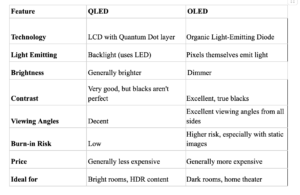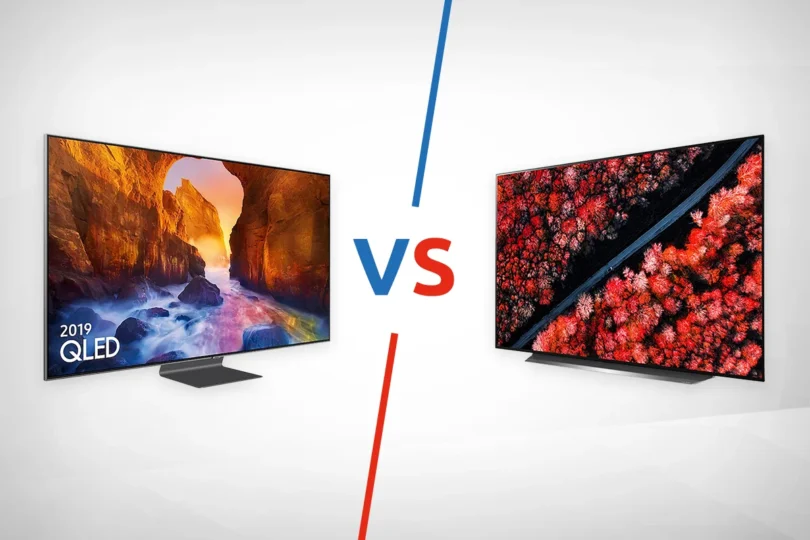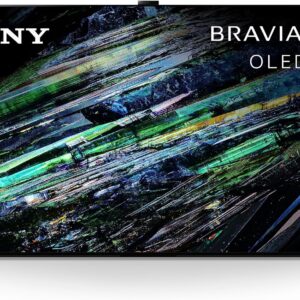Just when you start thinking that you have understood the tech words a little better, the tech world throws a curveball right at you. Well, it is the same case in the world of TVS. In fact, might think they are brothers of the same family with the acronyms. But apparently, they are not. OLED and QLED are two of the biggest technologies in the TV world. And here is your question: QLED or OLED TV which one is better?
OLED stands for Organic Light Emitting Diode, whereas QLED stands for Quantum (Dot) Light Emitting Diode. But if their names are nearly the same, what are the differences, and which one has the upper hand? You might have questions that you want to ask. So here is a guide to navigating both technologies.
What is OLED and what are OLED TV benefits?
OLED is an acronym for the terminology Organic Light Emitting Diode. It is one of the latest display technologies whereby the light is generated out of organic material. Compared with the conventional LCD screen which has a backlight, each OLED pixel is separately turned on by an electrical current. This design brings several benefits, such as enhanced picture quality with peak brightness, compactness, and thinness of screens, as well as higher refresh rates. OLED TV benefits are many as it can be used in many devices such as smartphones, TVs, and even the VR headset that you will be using.
Difference between OLED and QLED: QLED or OLED which one is better?
The two primary competing technologies for the premium segment at the moment are OLED and QLED, however, they work in fundamentally distinct manners when it comes to achieving an image. Here’s a breakdown of the key points to consider when choosing between them:
- Light Source: OLED means organic light emitting diode is a kind of electronic display device that has revolutionized the industry. Namely, every point in the OLED display has its light emission and can be switched off to obtain the black color at the deepest level. QLED, on the other hand, is an abbreviation for Quantum Dot Light Emitting Diode although it is not a fully emissive type of display. A quantum dot is a kind of LED-backlit LCD panel that lights up tiny particles called quantum dots, which in turn emit light of certain colors based on the backlighting given.
- Contrast: This is especially because OLED screens are self-illuminating thereby resulting in better contrast ratios compared to other LCD technologies. Completely off to the pixels, black becomes black and thus higher contrast ratio for even nearer to the real scene, particularly in the dark. QLED TVs cannot reproduce these blacks to the extent of true blacks, this is because there is still some backlight bleeding and this gives blacks a slightly grayish look.
- Brightness: QLED displays are not worse than OLED displays in terms of brightness level, to say the least. This makes them appropriate for highly illuminated environments or HDR media which have bright petals. OLED TVs have enough brightness for creating images in most of the rooms; however, do not shine in very brightly lit areas.
- Burn-in: Even though OLED is an excellent display solution, its implementation has a main disadvantage: the possibility of burn-in. Since organic materials are prone to erasing themselves over time, outlines of static images remain noticeable on the screen after a while. QLED since utilizes inorganic materials on its screen and therefore, is less vulnerable to burn-in.
- Viewing Angle: The viewing angle offered by both OLED as well as QLED television sets is far better than what one can get from a normal LCD screen. Bright and representatives of a greater number of points remain colors true from the correct
Top 3 OLED TV:
Advantages:
- Superior Image Quality: One of OLED’s big selling points is image quality for it emits light. As opposed to LCD screens that use backlights or LEDs, each pixel in an OLED screen creates its own light. This makes for perfect blacks – once the unit turns off a pixel it does not emit any light signals at all. This leads to unfathomable blacks, sharp image details, and tons of color helping to provide a more lifelike experience.
- Thin, Lightweight, and Flexible: OLED panels are even slimmer and lighter compared to other types of screens; the Liquid Crystal Display or LCD screens. This is because they speak for the organic materials as a source of backlighting as opposed to the rigid glass backlighting. This makes them suitable for making portable devices such as smartphones and tablets due to the need to make lighter and slimmer gadgets. Moreover, there are uncharted possibilities for the future folding and rolling OLED screens, giving hope for future device innovation.
- Energy Efficient: OLED pixels are only lit where necessary, unlike LCDs that continuously need to light their backdrop hence making OLED more power-conscious than LCDs. This adds up to enhanced battery life for your gadgets especially when they are displaying dark material.
- Faster Response Time: LCDs do not compete in terms of response time with OLED displays as they are far better by this characteristic. In simple terms, this means that it takes less time for the pixels to turn on and off and thus, the moving pictures that are displayed are much clearer with very little smearing. This has the added benefit of being especially useful for highly dynamic content such as video and games for a seamless playthrough.
What is QLED and What are its advantages?
Top 3 QLED TV:
QLED, which stands for Quantum dot Light Emitting Diode, is the latest technology applied for better display of images and videos. For this, QLED TVs employ a more conventional light source known as backlighting using LEDs as against to OLED’s emissions.
Advantages:
- Enhanced Color and Brightness: QLED TVs apply a layer of quantum dots on the top of the backlight. These dots vary in size and work by filtering and then emitting the required wavelength of light to produce many more colors than existing LCD-based solutions. This means we end up having more realistic and richer contrast visuals especially when it comes to HDR content. Furthermore, QLEDs are capable of high brightness ratings which is good for bright rooms and especially HDR content with bright details.
- Durable and Burn-in Resistant: In contrast to OLED which applies organic pigment that may wear out after exposure to static images, QLED is inorganic something very hard-wearing. This can only mean that they are less prone to the disturbing phenomenon of burn-in, particularly when it comes to static images that are left on the screen for a long period.
- Wider Size Availability and Lower Cost: The production technique of QLED TVs enables it to be done more often on larger dimensions as compared to OLEDs. This makes them overall suitable for people who desire a home theater experience of large-screened television sets. Also, as the structure of QLED is less complex than OLED, the price is still significantly lower, which makes QLED a balance between price and quality.
- High Energy Efficiency: Compared to OLED when presenting a black image QLED TVs are not as power-saving but are still okay. This is because they incorporate a far superior backlight system as opposed to the generally used LCD backlights.
QLED or OLED which one is Better for you?

Conclusion:
While it depends upon you, to answer the question: QLED or OLED Tv which one is better, as an audience to choose what you like, there are a few factors you must take into account. For example, affordability, or if it’s ideal for you. While both function extremely well in their own domain, it is upto you to find your comfort zone and technology.







